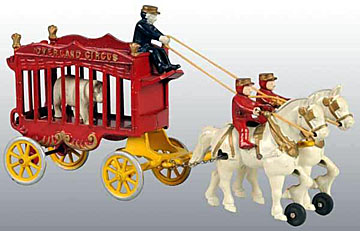QUESTION: Every Christmas since I can remember, our family has got out an old tine train set that belonged to my grandfather and set it up under the Christmas tree. It still runs and is in good condition. All we know is that the set was made by a German company named Märklin. What can you tell us about this company?
ANSWER: From the looks of your train, I’d say it dates from the 1920s or 1930s. At the time, these trains were more toys than authentic models. Their design reflects the boxy look of European trains rather than the sleeker, simpler lines of American ones.
 As the 1930s dawned, the Great Depression forced millions of people out of work. Owning an electric toy train was the ultimate. Kids even loved observing the trains displayed in department store windows. What could be more rewarding to a young boy than to receive a model train for Christmas? But these little trains were expensive so were out of reach of many families.
As the 1930s dawned, the Great Depression forced millions of people out of work. Owning an electric toy train was the ultimate. Kids even loved observing the trains displayed in department store windows. What could be more rewarding to a young boy than to receive a model train for Christmas? But these little trains were expensive so were out of reach of many families.
Manufacturers lovingly handcrafted the earliest toy trains, made prior to 1850, of shining brass to run on the bare floor. But by the late 1830's, a number of prosperous toy companies began producing toy trains. Around 1856, George W. Brown, a Connecticut firm, produced the first self-propelled train made of iron and coated with tin to prevent rust. A wind up clockwork motor drove the engine and carriages on plush Victorian carpets on straight or curved tracks.
 In 1859, tin smith Theodor Friedrich Wilhelm Märklin began producing doll house accessories made of lacquered tinplate. Although the Märklin Toy Company of Germany originally specialized in doll house accessories, It became known for its toy trains.
In 1859, tin smith Theodor Friedrich Wilhelm Märklin began producing doll house accessories made of lacquered tinplate. Although the Märklin Toy Company of Germany originally specialized in doll house accessories, It became known for its toy trains.
By the 1870's, the most popular trains were powered by steam. Utilizing alcohol or sometimes coal to propel. they duplicated the might and energy of their big, big brothers.
The tin toy makers in both Europe and the U.S. realized that profits could be made by selling toy trains to the masses and jumped on the toy model bandwagon. Early on, they set their sights on wealthier people by promoting their products’ snob appeal.
 In 1891, Märklin began producing wind-up toy trains that ran on expandable sectional tracks and the following year created a sensation by making the first figure eight track layout. It also established a track gauge settings numbered from 0 to 4, which it presented that year at the Leipzig Toy Fair. These track gauges soon became international standards. Märklin began producing 0 gauge trains as early as 1895 and H0 scale in 1935. In 1972, the company rolled out diminutive Z scale trains, the smallest in the world in competition to Arnold Rapido's introduction of N gauge.
In 1891, Märklin began producing wind-up toy trains that ran on expandable sectional tracks and the following year created a sensation by making the first figure eight track layout. It also established a track gauge settings numbered from 0 to 4, which it presented that year at the Leipzig Toy Fair. These track gauges soon became international standards. Märklin began producing 0 gauge trains as early as 1895 and H0 scale in 1935. In 1972, the company rolled out diminutive Z scale trains, the smallest in the world in competition to Arnold Rapido's introduction of N gauge.
Märklin’s owners noted that toy trains, like doll houses, offered the potential for future profits when, after the initial purchase, owners would expand by purchasing accessories for years to come. So, the company offered additional rolling stock and track with which to expand its boxed sets.
 Electric trains became commercially successful by 1897 when the Cincinnati, Ohio, firm of Carlisle and Finch manufactured and sold a two-gauge unit for only three dollars, It also was the first to issue a model railway builder's instruction manual.
Electric trains became commercially successful by 1897 when the Cincinnati, Ohio, firm of Carlisle and Finch manufactured and sold a two-gauge unit for only three dollars, It also was the first to issue a model railway builder's instruction manual.
Many consider the years prior to World War I to be the "Golden Age" of quality model trains. As the war approached, manufacturers converted their factories to produce war monitions, rifles and replacement parts. The Depression that followed the war precluded many of these operators from coming back and many disappeared.
But Märklin continued producing toy trains until May 11, 2006 when Kingsbridge, a London venture capital company, took it over. The company filed for bankruptcy on February 4, 2009, but on February 5, 2010, after purchasing the rival LGB Company, announced it had returned to profitable state. Many consider Märklin's older trains highly collectible today.
To read more articles on antiques, please visit the Antiques Articles section of my Web site. And to stay up to the minute on antiques and collectibles, please join the over 30,000 readers by following my free online magazine, #TheAntiquesAlmanac. Learn more about "Lady Luck" in the 2024 Fall Edition, online now. And to read daily posts about unique objects from the past and their histories, like the #Antiques and More Collection on Facebook.

















































